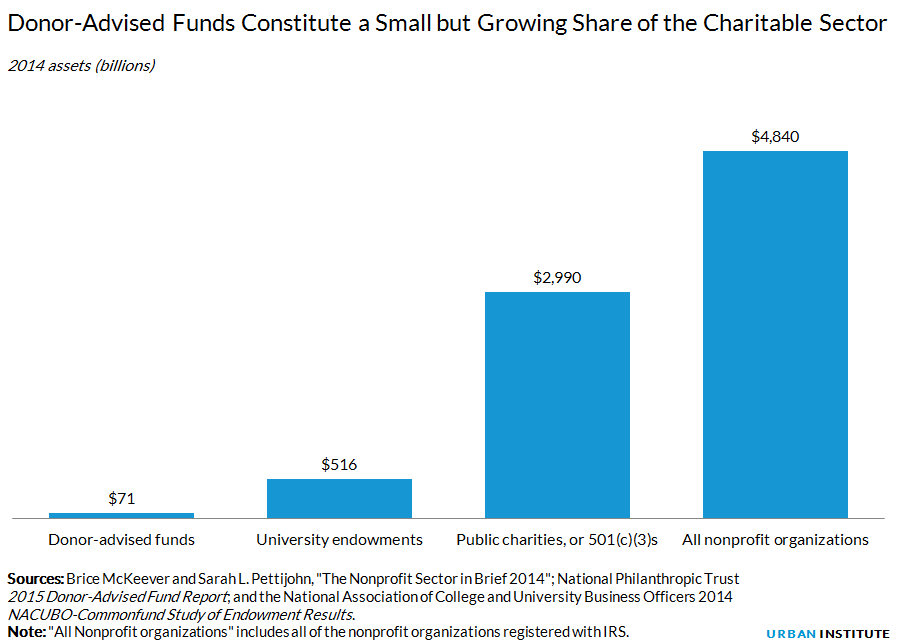
If the media reports are any indication, interest in donor-advised funds (DAFs) is on the rise. DAFs enable donors to claim a tax deduction by placing their donation in a fund run by a charity, which will later be distributed, under the advice of “donor advisers,” to other Internal Revenue Service–registered charities.
Recent headlines imply that DAFs reduced money distributed for charitable purposes, but that is misleading, if not wrong. In fact, because of additional investment gains that must be distributed and low overhead costs relative to other forms of endowed giving, DAFs tend to increase what charities receive over time. And by offering new, creative ways of giving, DAFs may increase taxpayer contributions as well.
But some still say that the money put into these and other forms of endowment should be spent more quickly, though payouts from DAFs now approximate contributions to them. So what are the real issues with DAFs?
Why some donors like DAFs
Community foundations have offered DAFs for decades, but more recently have been joined by national providers, the largest of which are Fidelity Charitable, Vanguard Charitable, and Schwab Charitable. Assets of DAFs totaled $70.7 billion in 2014, increasing from $33.6 billion in 2010.
Though DAFs are small compared with the charitable sector’s $5 trillion in assets and moderate in size compared with private foundation and university endowments, they are growing quickly in popularity among donors. Unlike many forms of asset and endowment holdings, including land, buildings, artwork, and private foundation assets, DAFs are efficient, flexible, adaptable, and carry low administrative costs.

As an added bonus, they allow donors to put the money aside in a charity, take a deduction, and decide later how to allocate that money.
To supporters, DAFs offer a unique opportunity to expand charitable giving. By granting middle-wealth donors the ability to endow their giving without establishing a foundation or separate charity (adding considerable administrative costs), DAF providers support a “democratization of giving.” DAFs can help donors save for a big-ticket donation down the road, such as building a new hospital wing or building the capacity of a small nonprofit. They are also popular among parents and grandparents who wish to pass down philanthropic values to the next generation.
To opponents, DAFs’ growing size makes them a target for suspicion and raises questions about whether the funds will increase net contributions. Some opponents object to endowments more generally. Some criticize the national DAF providers because, though set up as separate charities, they were created by commercial firms and tend to hold assets in financial platforms offered by those firms.
What DAFs mean for tax policy
DAFs have also received considerable attention in tax policy, including draft legislation put forward by the Ways and Means Committee in 2014. Last year, Urban’s Tax Policy and Charitiesinitiative clarified the charitable sector’s questions about DAFs and assessed whether those questions applied more broadly to assets held by all charities:
- Should Congress encourage endowments more or less? Earnings on endowments aren’t typically taxed, adding to the value of the original charitable contribution. How can a rule restricting assets, reserves, or endowments be applied consistently without favoring less efficient forms or favoring only the wealthy?
- Should endowments other than private foundations be required to make payouts, and if so, how frequently? On average, DAF-sponsoring organizations have much higher payout rates compared with foundations, but that is not true for each DAF. And should government deter activities where a buildup in assets makes sense (e.g., a community foundation dependent upon regular contributions from DAFs)?
- Should DAFs look more like foundations or vice versa? Current law encourages foundations to reduce their payouts when the economy goes sour, even though charities most need grants at those times.
- To what extent should capital gain property be given special treatment? If restricted once again, what type of rule can be applied consistently?
- Do we need additional disclosure rules for DAFs, and would these rules need to be extended to other charities that don’t have to disclose the same items?
- What fiduciary standards should apply to national DAF providers or any commercial business that operates closely with charities in ways that promote the business’s brand?
The rise of DAFs raises policy questions that affect the full spectrum of charitable organizations. Ultimately, the most important question surrounding DAFs is whether their efficiency and rapid growth offer new opportunities to expand charitable activity more generally.
Let’s build a future where everyone, everywhere has the opportunity and power to thrive
Urban is more determined than ever to partner with changemakers to unlock opportunities that give people across the country a fair shot at reaching their fullest potential. Invest in Urban to power this type of work.